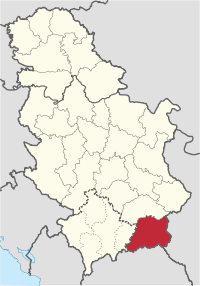Pčinja District
| Pčinjski okrug Пчињски округ | |
|---|---|
| District of Serbia | |
 Location of the Pčinja District within Serbia | |
| Country |
|
| Region | Southern and Eastern Serbia |
| Administrative center | Vranje |
| Government | |
| • Commissioner | Srećko Pejković |
| Area | |
| • Total | 3,520 km2 (1,360 sq mi) |
| Population (2011 census) | |
| • Total | 159,081 |
| • Density | 45.1/km2 (117/sq mi) |
| ISO 3166 code | RS-24 |
| Municipalities | 6 and 1 city |
| Settlements | 363 |
| – Cities and towns | 6 |
| – Villages | 357 |
| Website |
www |
The Pčinja District (Serbian: Пчињски округ / Pčinjski okrug, pronounced [ptʃǐɲskiː ôkruːɡ]) is one of nine administrative districts of Southern and Eastern Serbia. It covers the southern part of Serbia, bordering the disputed territory of Kosovo, Bulgaria and the Republic of Macedonia. Its administrative center is the city of Vranje.
It has a population of 159,081, according to the 2011 census. It is possible that the actual population is greater than is stated in the official statistics, because most Albanians boycotted the census; an estimate is that between 20,000–50,000 more people than recorded live in the district.
The Vranjska Banja spa plays a particular part in this region, with its multi-medicinal thermal mineral waters.
Municipalities
It encompasses the municipalities of:

Culture and history
The ancient Paeonian tribe of Agrianians (Agrianes) ruled the region of present Pčinja District.
The cultural-historic monuments date back over five centuries ago. The earliest military fortification: Marko's Fortress, originates from the thirteenth century. Also famous are the ancient Turkish Public Bath from the sixteenth century, and the Pasha's House from 1765, in which a Grammar School was opened in 1882.
In 2001, uprisings by Albanians occurred in the Albanian-majority municipalities of Preševo and Bujanovac. In addition, reports emerged in 2006 that the Trgovište had threatened to secede to Macedonia, which were treated as noteworthy because the area has a majority Serb population. Representatives cited economic hardship and a declining population as grievances against Serbia's government.[1]
Economy
The economy of Vranje is based on industry, mining, building industry, trade, agriculture, and forestry. The best known factories are: DIV Tobacco Factory and holding companies: SIMPO and Jumko.
Demographics
| Historical population | ||
|---|---|---|
| Year | Pop. | ±% p.a. |
| 1948 | 209,232 | — |
| 1953 | 220,910 | +1.09% |
| 1961 | 222,520 | +0.09% |
| 1971 | 230,373 | +0.35% |
| 1981 | 238,753 | +0.36% |
| 1991 | 243,529 | +0.20% |
| 2002 | 227,690 | −0.61% |
| 2011[a] | 159,081 | −3.91% |
| Source: [2] | ||
Ethnic composition
- 1992
- Serbs = 60.4%
- Albanians = 26.5%
- Roma = 5.7%
- Bulgarians = 4.4%
- Others = 3%
- 2002
- Serbs = 147,046 (64.58%)
- Albanians = 54,795 (24.07%)
- Roma = 12,073 (5.3%)
- Bulgarians = 8,491 (3.73%)
- Others = 5,285 (2.32%)
- 2011
- Serbs = 132,601 (83,35%)
- Roma = 13,826 (8.69%)
- Bulgarians = 7,287 (4.58%)
- Albanians = 680 (0.43%)
- Others
See also
Notes
| a. | ^ In the municipalities of Bujanovac and Preševo (parts of Pčinja District) there was undercoverage of the census units owing to the boycott by most of the members of the Albanian ethnic community. |
References
- ↑ "Lost in Shuffle, Serb Town Sees Future in Macedonia." New York Times, April 25, 2006.
- ↑ "2011 Census of Population, Households and Dwellings in the Republic of Serbia" (PDF). stat.gov.rs. Statistical Office of the Republic of Serbia. Retrieved 11 January 2017.
- Note: All official material made by Government of Serbia is public by law. Information was taken from official website.
External links
| Wikimedia Commons has media related to Pčinja District. |
- Пчињски управни округ (Serbian)